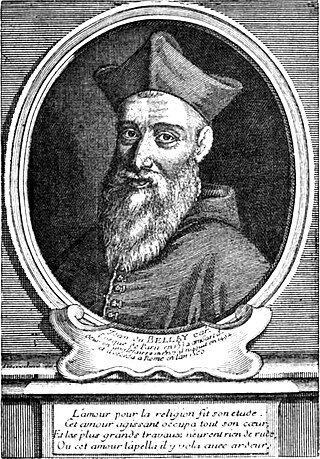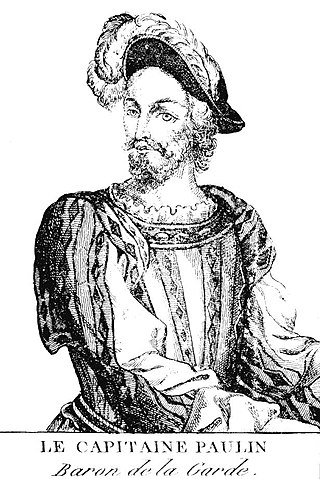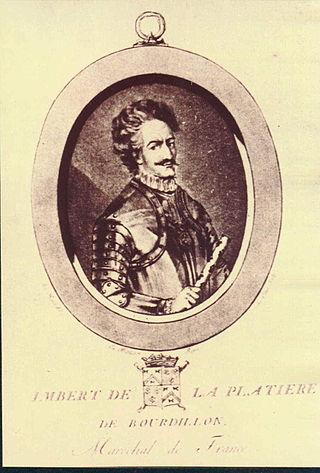
Jean de Thais (died 1553) was a French nobleman and officer during the Italian Wars.

Jean de Thais (died 1553) was a French nobleman and officer during the Italian Wars.
Jean was born in the château of Thais in Sorigny towards the end of the 15th century. His father was Aimery, lord ( seigneur ) of Thais and Sepmes (and son of Jacques, lord of Thais and Boissière, and Françoise d'Aloigny, lady of Sepmes). His mother was Françoise de la Ferté. [1] He had a sister named Jeanne, who married Louis Brossin, lord of Méré and Sepmes, on 24 April 1529. She died in 1572.
Jean married Charlotte, daughter of Antoine de Mailly, lord of Auchy and Neuville-le-Roy, and Marie d'Yaucourt. They had a daughter, also Charlotte, who married firstly Claude des Essars, lord of Sautour, and secondly René, comte de Sansay, hereditary viscount of Poitou.
Jean progressed rapidly in the service of King Francis I. In 1529, he became a panetier ordinaire (pantler) in the royal household. In 1530, he was one of six knights chosen by the king to defend a pas d'armes at the arrival of Francis's bride, Eleanor of Austria. [1] In 1534, he became a gentilhomme de la Chambre du roi and was dispatched as an ambassador to the Duchy of Ferrara. In 1538, he led an embassy to Rome and, in 1543, to Turin.
Jean played an active role in the Italian Wars. In 1544, he distinguished himself at the battle of Ceresole and the siege of Boulogne. On 1 October, he was promoted to the rank of colonel general of the infantry on both sides of the mountains, i.e., in France and Italy. [2] He was the first person to hold this position. He was also made a member of the Order of Saint Michael. Probably around this time he was put in charge of the waters and forest of Loches.
In July 1545, Jean was the commander of the French forces at the battle of Bonchurch. [3] On 21 January 1546, he was made grand master of the artillery. The death of Francis I and accession of Henry II on 31 March 1547 put an end to his military career. This was attributed to the substitution of Francis's mistress, Anne de Pisseleu d'Heilly, who favoured Jean, with a new one, Diane de Poitiers. Jean lost his generalship of the artillery on 11 April 1547, being replaced by Charles de Cossé, Count of Brissac. [4] He was replaced as colonel general of the infantry on 29 April by Gaspard II de Coligny. [5] He remained governor of Loches until he resigned the office to Honorat de Savoie, Count of Villars. [6]
In 1552, Antoine de Bourbon requested the service of Jean de Thais as a simple officer. Jean died at the siege of Hesdin on19 December 1553 and was buried in the choir of the church of Sepmes.
The Géomance of Christopher Cattan was dedicated to him.

The House of Bourbon is a dynasty that originated in the Kingdom of France and is a branch of the Capetian dynasty, the royal House of France. Bourbon kings first ruled France and Navarre in the 16th century, and by the 18th century, members of the Spanish Bourbon dynasty held thrones in Spain, Naples, Sicily, and Parma. Today Spain and Luxembourg have monarchs of the House of Bourbon. The royal Bourbons originated in 1272, when Robert, the youngest son of King Louis IX of France, married the heiress of the lordship of Bourbon. The house continued for three centuries as a cadet branch, serving as nobles under the direct Capetian and Valois kings.

Jean du Bellay was a French diplomat and cardinal, a younger brother of Guillaume du Bellay, and cousin and patron of the poet Joachim du Bellay. He was bishop of Bayonne by 1526, member of the Conseil privé of King Francis I from 1530, and bishop of Paris from 1532. He became Bishop of Ostia and Dean of the College of Cardinals in 1555.

Jean de Lorraine was the third son of the ruling Duke of Lorraine, and a French cardinal, who was archbishop of Reims (1532–1538), Lyon (1537–1539), and Narbonne (1524–1550), bishop of Metz, and Administrator of the dioceses of Toul, Verdun, Thérouanne, Luçon, Albi, Valence, Nantes and Agen (1538–1550). He was a personal friend, companion, and advisor of King Francis I of France. Jean de Lorraine was the richest prelate in the reign of Francis I, as well as the most flagrant pluralist. He is one of several cardinals known as the Cardinal de Lorraine.
French Renaissance literature is, for the purpose of this article, literature written in French from the French invasion of Italy in 1494 to 1600, or roughly the period from the reign of Charles VIII of France to the ascension of Henry IV of France to the throne. The reigns of Francis I and his son Henry II are generally considered the apex of the French Renaissance. After Henry II's unfortunate death in a joust, the country was ruled by his widow Catherine de' Medici and her sons Francis II, Charles IX and Henry III, and although the Renaissance continued to flourish, the French Wars of Religion between Huguenots and Catholics ravaged the country.

Antoine Sanguin was a French cleric, courtier and Cardinal. He was the second son of Antoine Sanguin, Seigneur de Meudon and Maître des Eaux-Forêts de l'Isle de France, Champagne et Brie; and Marie Simon, daughter of Jean Simon, Seigneur de Marquemont. The younger Antoine had a brother and three sisters; his sister Anne was married to Guillaume de Pisseleu. He was therefore the uncle of Anne de Pisseleu d'Heilly, mistress of François I, to whom he owed his ecclesiastical career; there is no record of his having taken holy orders.

François d'Andelot de Coligny was one of the leaders of French Protestantism during the French Wars of Religion. The son of Gaspard I de Coligny, he was the younger brother of Odet, cardinal de Châtillon and Gaspard de Coligny the admiral.

Guillaume Desautels (1529-1599) was a French poet of the sixteenth century associated with La Pléiade.

François de Scépeaux de Vieilleville, lord of Vieilleville, 1st comte of Durtal, was a French governor, diplomat, ambassador, conseillé du roi and marshal. During his career, he would serve four French kings. He fought throughout the later years of the Italian Wars, acquiring for himself the key frontier governorship of Metz in 1553. Under King Charles IX he would be elevated to marshal and would serve the crown in the early religious wars, increasingly in the role of peacemaker and diplomat, though with scattered military service as with the recapture of Le Havre in 1563. He died in 1571, shortly before France would be shaken by the St Bartholomew's Day Massacre.

Claude de Longwy de Givry (1481–1561) was a French bishop and Cardinal, from an aristocratic background. He was the son of Philippe de Longuy, Seigneur de Givry and Jeanne de Beautremont, Dame de Mirabeau. He had four brothers: Jean de Longuy, Sieur de Givry and Baron de Mirabeau, Christophe de Longuy, Antoine de Longuy, and Étienne de Longuy. Claude's aunt Jeanne had married Guy de la Baume, Count de Montrevel, and one of their sons was Cardinal Pierre de la Baume (1539-1544), Prince and Bishop of Geneva (1522-1543).

Antoine Escalin des Aimars, also known as Captain Polin or Captain Paulin, later Baron de La Garde, was French ambassador to the Ottoman Empire from 1541 to 1547, and "Général des Galères" from 1544.

Bernard Salomon (1506–1561), also known as the Little Bernard B. Gallus or Gallo, was a French painter, draftsman and engraver.

Conrad Schetz de Grobbendonck, later Conrad d'Ursel (1553–1632) was a nobleman in the Habsburg Netherlands and in 1604–1609 the first ordinary ambassador to England for the Archdukes Albert and Isabella.
The Counts of Dammartin were the rulers of the county of Dammartin, based in the current commune of Dammartin-en-Goële as early as the 10th century. Located at the central plain of France, the county controlled the roads of Paris to Soissons and Laon. It seems that this county was initially held by Constance, the wife of Manasses Calvus, the first Count. The name Dammartin-en-Goële comes from Domnus Martinus, the Latin name of St. Martin of Tours, who evangelized the region of Goële in the fourth century. A small town in the district of Meaux in the Department of Seine-et-Marne, ancient village of Region of Île-de-France, it appears to go back to the earliest times; Dammartin-en-Goële, also called Velly, was in 1031 one of the most significant places in France.
Jean Bastier de La Péruse (1529–1554) was a 16th-century French poet and playwright.
Marc-Claude de Buttet was a Renaissance poet, courtier and humanist. He formed part of the La Pléiade circle. He was lord of the feudal rent of Grésy in the province of Genevois.

Robert IV de La Marck was Duke of Bouillon, Seigneur of Sedan and a Marshal of France. He rose to prominence during the reign of Henri II of France as a favourite of both the king and his mistress Diane de Poitiers. In 1547 he was elevated to the rank of Marshal of France. In 1549 he established himself as a sovereign prince, with Sedan, France granted the status of a principality. In 1552 he was granted the office of governor of Normandy, an office that historically gone to Normans or members of the royal family.

Imbert de La Platière, lord of Bourdillon (1516–1567), was a French army officer and Marshal of France. He began his career under Francis I, fighting at the famous victory of Ceresole in 1544. During the reign of Henri II he continued to receive career advancements, becoming Lieutenant general first of Champagne and Brie in 1553, and then the important border fortresses in the Piedmont in 1559. Having fought for the crown during the Italian Wars he continued to serve loyally as the French Wars of Religion began, becoming a Marshal in December 1562 on the death of Paul de Thermes, aiding in the enforcement of the Peace of Amboise after the first religious war, and being sent to crush the nascent religious leagues in 1565. He died in 1567, shortly before the civil wars resumed.

Jean II Babou was a French soldier, notable as grand-bailiff (grand-bailli) of Touraine and France's Grand Master of Artillery (1567). He was Lord of La Bourdaisière, count of Sagonne, Lord of Thuisseau, Chissé, Vouillon, Pruniers, Germigny and Brain sur l'Authion.
Jean V de Parthenay-L'Archevêque, or Larchevêque, Sieur de Soubise , was a Protestant French nobleman, last lord of Mouchamps, from the Parthenay-l'Archevêque family. His father, Jean IV de Parthenay, died before he was born. His mother was humanist Michelle de Saubonne. He married Antoinette d'Aubeterre, and their daughter and was Catherine de Parthenay, who later married René II, Viscount of Rohan.